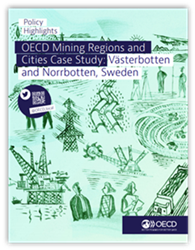Développement régional, urbain et rural

Mining Regions and Cities Case of Västerbotten and Norrbotten, Sweden
Sweden’s northern region, Upper Norrland, is one of the most important mining regions
in Europe and has the potential to become a global leader in environmentally sustainable
mining. With the largest land surface and the lowest population density in Sweden,
Upper Norrland contains two sub regions, Västerbotten and Norrbotten. Both sub regions
host the greatest mineral reserves in the country, containing 9 of the country’s 12
active mines and providing 90% of the iron ore in the European Union. Upper Norrland
has the potential to become a global leader in environmentally sustainable mining
due to its competitive advantages, including a stable green energy supply, high-quality
broadband connection, a pool of large mining companies working closely with universities
to reduce the emissions footprint across the mining value chain, and a highly skilled
labour force. Yet, the region must overcome a number of bottlenecks to support a sustainable
future, including a shrinking workforce, low interaction of local firms with the mining
innovation process and an increasing opposition to mining due to socio environmental
concerns and land use conflicts. This study identifies how Västerbotten and Norrbotten
can build on their competitive advantages and address current and future challenges
to support a resilient future through sustainable mining.
Available from January 27, 2021
In series:OECD Rural Studiesview more titles
TABLE OF CONTENTS
| Foreword | |
| Abbreviations and acronyms | |
| Executive summary | |
| Assessment and recommendations | |
| Strengths and challenges in the regional development of Västerbotten and Norrbotten | |
| Unlocking development opportunities with an enhanced mining ecosystem for Västerbotten and Norrbotten | |
| Setting the right frameworks for sustainable mine development in Upper Norrland |
Powered by OECD iLibrary
